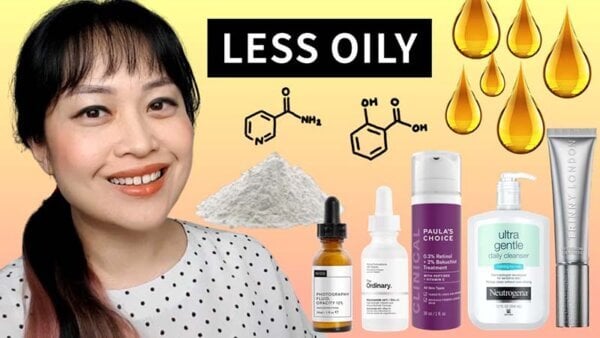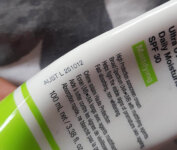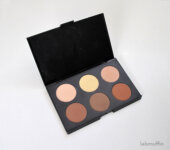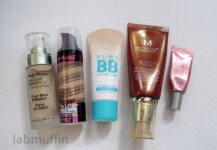My skin is oily / combo and I complain about it quite a lot, so I often get asked for my best tips for controlling the inevitable flood of oil. I also sweat easily which apparently means I’m fit, but this adds to the oil and I end up a bigger mess.
I’ve spent a long time trying to get the right balance of products and routines to combat the oil – here are my best skincare and make-up tips!
The video is here, keep scrolling for the text version.
Tip 1: Is Your Skin Actually Oily?
The first thing you want to check is: Is your skin actually oily?
Oily skin is genetic, but sometimes the wrong skincare routine can irritate your skin, and that can make normal or even dry skin leak out a whole bunch of oil. So it might look like your skin is oily, even if it’s not.
Oily skin can also be dehydrated, which means it’s lacking water even if there’s too much oil. This leads to a pretty common, dry-but-oily situation where your skin feels tight and dry and cracked, but is also covered in a thin layer of oil. A lot of people who think they have dry skin actually have dehydrated skin.
Related post: Is Your Skin Dry or Dehydrated? And How to Treat It
Unfortunately, I’m in the truly oily camp (technically oily/normal combo, since my cheeks are more towards normal). Having skin that’s prone to becoming dehydrated, combined with a bad skincare routine, made my oily skin even oilier.
So if you’re frustrated with too much oil, you’ll want to first make sure you’re not accidentally making things worse.
If you want a really detailed guide to doing a skin evaluation and a rundown of the different skin types and conditions, I’ve made one in my Guide to Basic Skincare.
So let’s say you’ve confirmed your skin is actually oily. What can you do?
Tip 2: Wash your skin gently
It’s very tempting to wash with harsh cleansers to cut through the oil and dry it out. DON’T DO THIS. THIS IS A TRAP.
Harsh cleansers will strip away both oil and your natural moisturising factor (NMF). This is a collection of chemicals that are naturally in your skin. They hold onto water and keep your skin hydrated – they’re your skin’s natural humectant moisturiser.
Harsh surfactants can also warp the shape of the proteins in your skin barrier, leading to loss of water – again, dehydrated skin.
Your skin has also evolved to be very responsive to barrier disruption. When your skin’s disrupted, it’s triggered to release more oil to keep your skin conditioned… which means more of that whole mirrorball situation. It’s a vicious cycle.
So gentle cleansing is the way to break out of this. If your skin feels tight and dry after washing, you’re probably overdoing it. It should feel soft and plump.
Related post: Are You Washing Your Face Wrong? Busting Cleanser Myths (with video)
If you’re used to bone-dry clean skin after washing your face, gentle washing might actually feel like your face isn’t clean – it does take some getting used to! But gentle cleansing was the number one thing that helped me, and a lot of other people with oily skin.
There are a lot of things that go into finding a gentle cleanser, but the easiest thing to do is avoid sodium lauryl sulfate in the top ingredients of your cleanser, and to avoid soaps (e.g. sodium or potassium palmitate/stearate/olivate/tallowate). Their molecules are quite slim so they insert themselves into your skin easily, staying there and irritating it.
Related: The Lab Muffin Guide to Basic Skincare
On a related note…
Tip 3: Try washing your face less
Even gentle cleansers can cause a bit of this dehydration-then-oil-production effect, which is why I think it’s worth trying just cleansing with cleanser once a day.
I personally only cleanse properly at night. In the morning, I just splash my face with water and then pat it dry with a towel before doing the rest of my morning routine. Since I clean my skin properly at night before I put on my evening skincare products, there isn’t much on my face in the morning.
Skincare products don’t just sit on your face in one big film that blocks everything else from entering. I think we tend to think of skin as something akin to solid glass, but it’s more like a burger bun. Substances in your skincare products sink in and mix with your skin’s components, and you can’t really get everything off without also removing a lot of the bun (i.e. your skin’s components). So I’ve found that water in the morning is enough.
Cutting down my skin’s exposure to cleansers has helped with the oil a lot. I’ve found that my oil comes back slower throughout the day instead of in one big flood. Plus the uncomfortable, tight feeling and greasy dehydrated-but-oily situation has died down a lot. Instead of having tight skin with oil on top (kind of like a greasy flaky plastic film situation), the oil seems to sink in a bit more nicely, and it’s more dewy rather than greasy. And a lot of other people with oily skin have found this works for them too!
I do sometimes cleanse a second time in the middle of the day, if I’ve been wearing a mask, or I want to take off my makeup early. When I do that I use Bioderma micellar water, which is super gentle and designed for sensitive skin, without standard wash-off cleansing surfactants.
A few gentle cleansers that I like:
- Hada Labo Gokujyun Super Hyaluronic Face Foam
- Bioderma Sensibio Mild Cleansing Foaming Gel
- Heimish All Clean Green Foam
- Bondi Sands Fresh’n up Nourishing Gel Cleanser
- Azclear Foaming Wash
But remember that everyone’s skin is different, so it’s important to work out what your skin likes. And it’s possible that your skin prefers being cleansed twice a day. But I think it’s worth experimenting with this if you haven’t already.
Tip 4: Sort out your moisturising routine
It’s tempting to think that if your skin’s oily, it doesn’t need any more moisturiser since it supplies way too much of its own. But again, like the cleansing thing, this can be a trap. Your skin’s natural oil isn’t that good at moisturising.
There are three main ways of moisturising your skin:
- Humectants grab onto water and keep it in the skin
- Occlusives seal water in
- Emollients soften your skin
Your natural sebum doesn’t do the first two very well, so it just softens your skin – it doesn’t actually help with water retention.
Related post: Fact-check Feature: How to choose a moisturiser
If your skin is hydrated and oily, then you might not need a moisturiser since you have enough of both water and oil. But if your skin’s dehydrated and oily, which is the case for a lot of people like me, a hydrating moisturiser that includes humectants and occlusives can keep your skin’s barrier maintained and help control the oil.
I like to use lightweight products like toners with lots of humectants during the day, and less occlusives since they can be a bit greasy. I try to use hydrating sunscreens, and I use a moisturiser at night. Sometimes I layer an occlusive product over a humectant for extra hydration. All of this attention to moisturisers has made a big difference!
Tip 5: Salicylic acid is great for pores
Salicylic acid, commonly known as beta hydroxy acid or BHA, is a chemical exfoliant and anti-acne skincare ingredient. It’s commonly recommended for oily skin because it’s oil-soluble, which means it’s more likely to be able to penetrate into blackheads and clogged pores, exfoliating inside them. This can help reduce breakouts and blackheads.
Related post: Affordable Acne Routine: Bumper Guide
As far as I know, there hasn’t been any actual studies on whether there’s actually greater oil penetration with salicylic acid relative to AHAs, but it sounds pretty reasonable. I’ve personally found that my pores look less noticeable when I’ve been consistently using salicylic acid. My favourite is Paula’s Choice 2% BHA Liquid, but there are a few different options (although none of them have worked as well on my skin).
And if you want to find out more about exfoliation in general, I have a free guide!
Related: Essential Guide to Exfoliation
Tip 6: Try some oil-reducing skincare
Unfortunately there aren’t that many skincare ingredients that can reduce the amount of oil on your face, and there’s only usually a single study on each of the ones that have been found to reduce oil production. So this approach isn’t very reliable, and they might not actually work in practice. But if you want to try some, here’s the stuff with the most evidence:
Related post: My Routine for Starting on Tretinoin (Retin-A) Cream (with video)
Clay masks are also good at soaking up oil, although you need to use them regularly to get the benefits since it’s pretty temporary (although not that temporary – twice a week usually works well).
Tip 7: Get the right translucent powder
Translucent powder is one of the most essential products in my routine for soaking up oil. This is powder that doesn’t look obvious on your face, so it’s really good if you don’t like to wear obvious makeup, and you can use this over just sunscreen as well.
The ingredient that I’ve found best for me is starch, so I always look for starch high up in the ingredients list. I’ve also tried using corn starch from the grocery store, which actually works reasonably well, although a proper product is easier to use. Clay also tends to be pretty good at soaking up oil.
Related post: DIY Mattifying Face Powder: Just a bag of corn starch
I use a big fluffy brush and try to concentrate the powder on my T-zone and the bits around my nose where I tend to get shiniest. My favourite powder is the Jurlique Rose Silk Finishing Powder.
The Wayne Goss method works well for some people – this is where you put a layer of powder underneath your foundation, so it soaks up the oil before it gets to the surface, so foundation won’t slide around as much.
Tip 8: Try dewy makeup
It’s been so ingrained in my head over the years that matte makeup is the way to go for oily skin – to just beat the mirrorball into submission.
But I’ve actually found that dewy make-up works better for me. When I do get oily, the contrast between the oily and non-oily parts isn’t as obvious, so I look more healthy than patchy.
I usually add highlighter powder on the tops of my cheeks and the tip of my nose, and a little on my forehead as well. Then I layer starch powder lightly on top, and keep topping that up as needed throughout the day.
Dewy makeup is also a bit easier to blend back in with your fingers when it moves around over the course of the day.
Back on the topic of moisturising – try hydrating your skin before you put makeup on, such as with a hydrating toner like Klairs Supple Preparation Toner.
Hydrating your skin makes it plumper and less textured, can smooth out fine lines and reduce flaking. This means pigment doesn’t have as many roadbumps on your face that can make it bunch up.
There are a lot of silicone-based anti-oil makeup products and pore-filling primers available, but I’ve found that these often make me greasier. They’re good for about half an hour until the oil soaks into them, then I start looking like I’m made of melting wax. It’s not a good look! But silicones do work for a lot of oily-skinned people.
Tip 9: Try using less pigmented makeup
This is not going to be possible or practical for a lot of people, but using base products (foundation, tinted moisturiser) with less coverage can be helpful. Essentially, the less pigment you have on your skin, the less stuff there is that can move around and bunch up.
For example, you can try using a sheer foundation all over, then a heavier foundation or concealer only on the bits that need more coverage.
I love Trinny London BFF Serum DeStress, a sheer foundation that makes your skin glowy and smooths it out, but still looks very natural. Then I pat The Ordinary’s concealer on the bits that aren’t covered enough. So in total, there’s less pigment on my face, so the patchiness and bunching just aren’t as obvious when it happens (and it will happen).
You can also try using a product like NIOD Photography Fluid , which has light reflecting particles that diffuse light and give the illusion of radiance, without containing skin coloured pigments. I’ve found that I can use less foundation if I add a few drops, or layer it underneath.
Tip 10: Look into medical treatments
There are a few medical treatments that will reduce oil production, although that’s usually not the reason they’re prescribed. Excess oil production contributes to acne, so many acne medications will reduce oil production as a side effect, including:
The latter two work because too many androgens (male sex hormones) can cause excess oil production, and they reduce them.
These options aren’t suitable for everyone with oily skin, but if you have acne as well it might be worth speaking to a doctor about whether they’d be appropriate for your situation.
There are also some treatments that have been investigated for reducing oil, like botox and light treatments. But they’re pretty expensive, and the evidence behind their effectiveness isn’t super convincing yet.
Let me know in the comments if there’s a tip I didn’t cover, and if these tips worked for you!
Many products mentioned were provided for editorial consideration or as part of sponsorships, which did not affect my opinion. This post also contains affiliate links – if you decide to click through and support Lab Muffin financially (at no extra cost to you), thank you! For more information, see Disclosure Policy.






Thank you!
I got like a white solid flake on the bottleneck of 2%BHA Paula choice, is that normal? Or what is it? Thanks
I think it might just be spilled product drying out, probably salicylic acid.